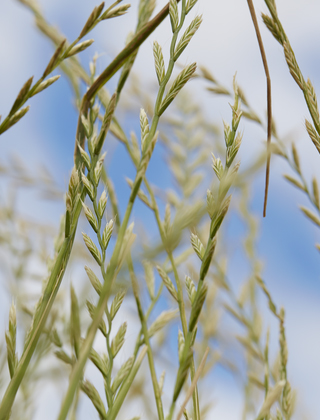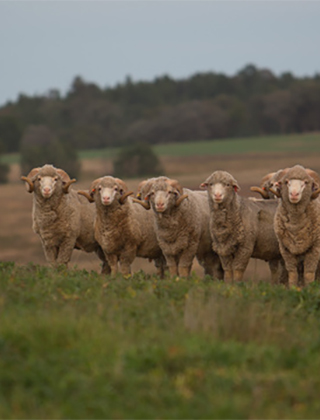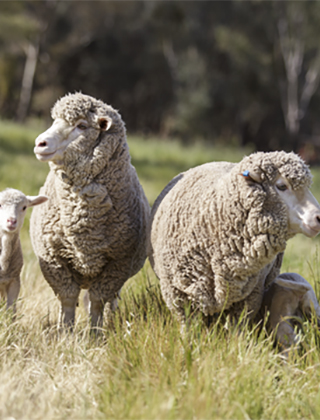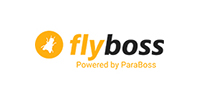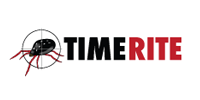Are your rams ready for action?
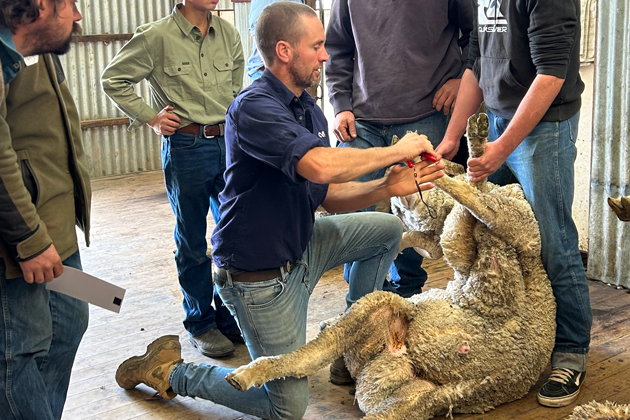
Rams are high performance animals that work very hard over the joining period. They contribute half of the genetics of their progeny and are the primary drivers of genetic improvement in a flock, so need to be given every opportunity to pass on their genes.
Image: RAMping Up Repro deliverer, Tom Graham from Coolac Vet Services, demonstrating how to safely conduct a pre-joining ram check at the September 2024 AWI Extension NSW & Zoetis RAMping Up Repro workshop in Laggan, NSW.
Author: Emily King, AWI National Extension Manager
Check your rams now
Whether you’re a spring or autumn joiner, now is the time to check your ram team is fit and functioning, so you know if you have enough rams for the upcoming joining period or can find out how many you need to purchase to replace the rams you have to cull out.
It’s easy to leave rams in the ram paddock and forget about them until you need to put them out with the ewes, but with a bit of easy preparation your ram team will be fighting fit and rearing to go.
Rams need to be in top condition to perform for the few weeks of joining each year. To cover ewes effectively, rams need to be able to eat and convert nutrients and maintain the ability to walk, mount and serve.
To avoid unnecessary loss of production due to poor reproductive performance, inspection and preparation of your ram team is a critical part of your management calendar.
Getting bang for your ram buck
Rams are a considerable investment for a woolgrower’s business. The best way to get the most out of your rams is to get as many live lambs on the ground as possible – after all, you bought him or bred him, so you want his genetics in your flock. Achieving this is a combination of:
There are three main strategies to improve the return on investment on your ram purchases:
- Optimise your ram joining percentage – purchase only as many rams as you need and use them well. This strategy relies on excellent preparation of your ewes and rams for joining success, making sure the ram team is in good nick and ready for their tour of duty. The optimum joining percentage varies based on several factors, including the age of the ewes you’re joining and landscape factors (such as whether you have very hilly country or huge paddocks with multiple watering points).
- Get more years out of each ram – this spreads the initial investment cost over more years, reducing the cost per live lamb. Well cared for, structurally sound rams stay fit for longer and are less prone to breaking down.
- Increase your lamb marking percentage – to spread the cost of the initial investment over more progeny and increase the selection pressure you can place on retaining replacement ewe lambs that best suit your breeding objective.
Ram performance is heavily impacted by management and preparation for joining. By managing your ewes and rams proactively and completing pre-joining ram inspections, you can expect higher output from your rams, allowing you to use your investment to its full potential.
Get hands on with the boys
The importance of a full pre-joining ram check can not be overstated! To do a full pre-joining ram check, you need to get your hands on your ram team and perform a physical inspection.
The full sperm cycle (spermatogenesis) takes six weeks to complete, so any check in the ram’s health in the weeks prior to joining can result in a compromised outcome.
Pre-joining ram checks should be completed 8–12 weeks prior to joining to allow you to pick up any issues and treat them or source replacement rams with sufficient time to allow for the full sperm maturation cycle to complete.
The steps of a pre-joining ram inspection are laid out in this handy RAMping Up Repro Checklist for pre-joining that you can put on your fridge, but the highlights include:
- Rams in condition score (CS) 3.5 for joining: to optimise sperm health and volume and ensure they have enough in the tank to last through joining.
- Nutrition: if your rams’ paddock nutrition is inadequate to maintain or get them to CS 3.5 for joining, you will need to offer them supplementary feed to reach the target CS. If your ewes are being supplementary fed, remember to acclimatise your rams to this feed before they hit the joining paddock to avoid complications with grain poisoning.
- General health check: check for lameness, cuts, sores or any signs of infection.
- Check the 4 Ts:
- Teeth: rams should have a sound mouth with good alignment of the teeth with the upper pad to eat well and stay in target condition score.
- Toes: be on the lookout for any swelling, discharge, odours and overgrown horns, and treat accordingly if they’re present.
- Tackle: check the penis and prepuce for signs of inflammation or infection. If you see anything suspicious, consult your veterinarian.
- Testes: gently feel both testes and the head and tail of the epididymis by holding the scrotum in your hands and running your hands up and down. The testes should feel smooth, evenly sized, firm and springy, with no lumps or adhesions. Target scrotal circumference for young rams is >28.5 cm, and >32 cm in adult rams. If you see or feel anything suspicious, consult your veterinarian.
- Shearing: rams should be shorn 8–12 weeks prior to joining to avoid sunburn, infection, allow any cuts to heal, give them time to grow enough wool to insulate them from weather fluctuations, and allow the full sperm cycle to take place after the busy shearing period. It is also worth noting that rams that have been sedated for shearing have reduced ability to regulate their body temperature while the sedative is still active in their system. It’s advised to return rams back onto grating or into a shady (when hot) or protected (when cold) paddock with access to water and hay before slowly returning them to their paddock later.
- Vaccination: best practice recommendation is to treat rams with a 6-in-1 vaccination.
- Parasite control: ensure your rams are protected from fly, worm and lice infections by using appropriate control measures and treat any existing infections to ensure the sperm cycle isn’t unnecessarily interrupted.
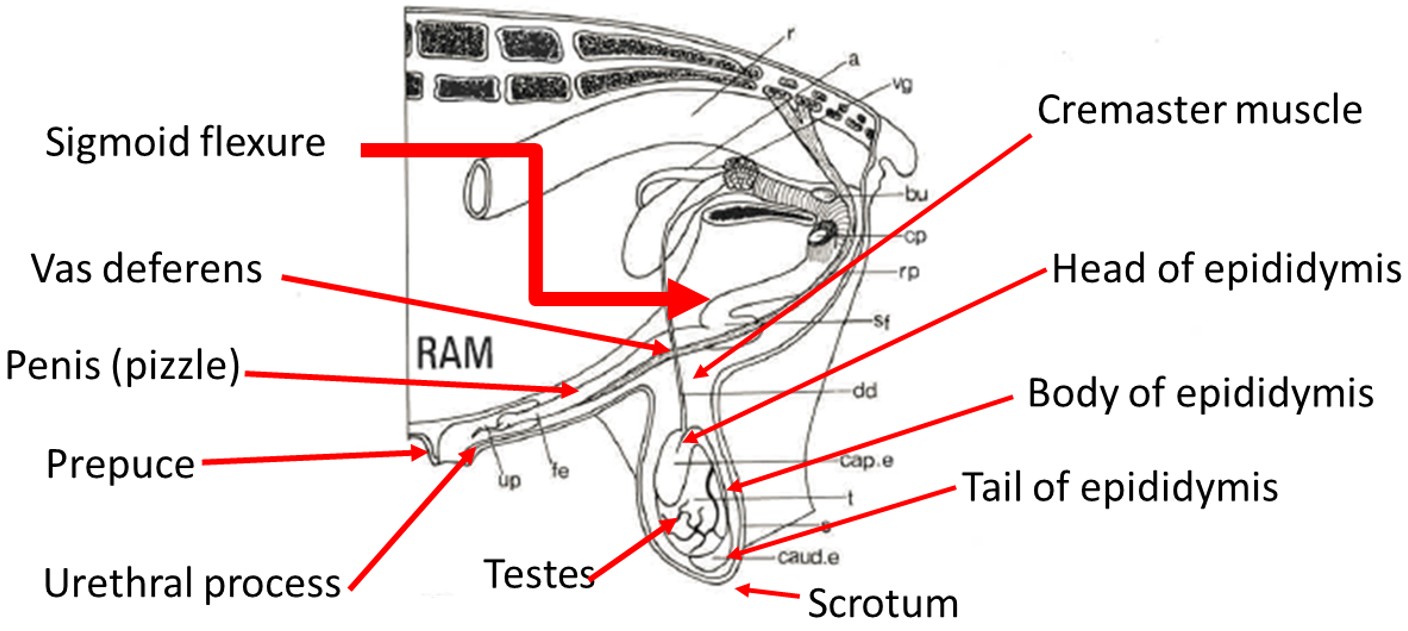
Diagram of the male reproductive tracts of a ram.
Image source: Hafez 1974, adapted by AWI & Zoetis
Quarantine all new purchases
As a rule, a 21-day quarantine period is recommended for all sheep coming onto your property, whether they’re coming home from agistment, stray sheep being returned home, or new purchases being brought onto farm.
It’s much better to prevent an animal health issue than to spend a lot of money trying to treat and eradicate it later. Key quarantine recommendations are to:
- Request a National Sheep Health Declaration and review before buying sheep and transporting them to your property.
- Drench all incoming sheep with four unrelated drench active ingredients, one of which should be one of the new actives (derquantel or monepantel). This needs to be done in two drench applicators and the drenches must not be mixed (i.e. go down the race with one drench and then go down the race a second time with the next drench).
- Check for lice. Visual inspection will pick up advanced infestation but not low levels, so to be sure, buy rams that are clean shorn and treated, or treat with an effective lousicide as per the label instructions on the product.
- Check the history of footrot on the farm of origin and inspect the condition of feet before unloading rams. Keep new sheep quarantined for at least seven days and check their feet again to ensure no visible signs of footrot. The footrot bacterium, Dichelobacter nodosus, survives off sheep for up to seven days, so ensure none of your sheep pass over the ground the quarantined sheep were on for at least another seven days.
- Avoid Johne’s disease (JD) and Ovine brucellosis (OB) if possible as there is no cure for these diseases:
- Johne’s disease (JD): buy sheep with lower risk of JD from a SheepMAP accredited flock or recent testing of a closed flock; vaccinate your flock if there is a risk of JD coming in from straying stock from neighbours or you’re in a district with high prevalence; and improve your flock’s resistance to disease through good nutrition and worm control.
- Ovine brucellosis (OB): palpate testicles to check for lumps before purchasing and before joining; complete thorough on-farm pre-joining ram inspections; seek veterinary advice if you notice lower scanning percentages, longer lambing periods or abnormal lumps in the testes; only buy rams with a National Sheep Health Declaration and from studs accredited as OB-free (each state ag department maintains a register); maintain ram-proof fences to avoid visits from neighbours’ rams; isolate new rams from your existing ram team until you’ve inspected both and ruled out OB (rams can spread OB between themselves in the ram paddock); isolate rams from ewes until their disease status is known as ewes can spread OB (though generally don’t suffer significant symptoms themselves).
Safety whilst handling rams
Last but not least, it’s crucial to protect yourself whilst inspecting and working with rams. Rams are big, strong animals that often don’t take kindly to being sat on their behind and having their bits and pieces checked.
Performing ram checks is best done as a two-person job (for example, on the board in the shearing shed) or in a sheep handler or ram cradle, if you have one or have access to one.
If you’d like a professional opinion when doing ram checks, many local veterinarians and livestock advisors can be engaged to undertake the service on-farm. You can also attend an AWI & Zoetis RAMping Up Repro workshop (run by the AWI Extension Networks and Zoetis) to learn how to safely and confidently perform a full ram pre-joining inspection and manage your ram team for optimum performance.
More information
- AWI Change Makers Episode 3: Ram performance management
- AWI Change Makers Episode 5: Joining time and length
- AWI Extension NSW webinar – March 2023: Ram management and brucellosis
- AWI & Zoetis RAMping Up Repro: Checklist for pre-joining
- AWI Beyond the Bale: Keeping up to scratch with vaccinations
- AWI Beyond the Bale: Shearing rams – what to consider
- Making More From Sheep: Boost business with breeding
- Making More From Sheep fact sheet: Brucellosis
- Making More From Sheep fact sheet: Johne’s disease
- Making More From Sheep fact sheet: Clostridial diseases
- Making More From Sheep: Tool 11.8 Management of worms
- Making More From Sheep: Tool 11.9 Management of drench resistance
- Making More From Sheep: Tool 11.13 Diagnosis, control and eradication of footrot, lice, JD and OB
- AWI & Zoetis RAMping Up Repro workshop






